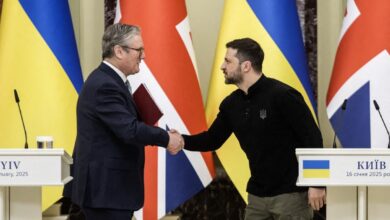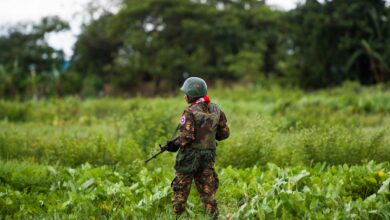First video of Bangladesh al-Qaeda fighters in Afghanistan appears online
KUALA LUMPUR, Malaysia – The first video purportedly showing Bangladeshi al-Qaeda fighters launching attacks against foreign forces in Afghanistan has emerged online.
The over 12-minute video in Bengali was first posted on an online library last week before it was uploaded to several other websites. It features several supposed Bangladeshi fighters preparing for and launching attacks in the conflicted nation.
Around a dozen men are first shown preparing for what appears to be an artillery system attack from high ground. It also shows their low-lying target, a blue-roofed compound that the video claims houses U.S and Afghan troops.
One man, whose face is blurred, appears to be the unit’s leader and gives a pre-attack briefing.
Later, the militants are seen firing four shots which draw a barrage of automatic gunfire in response.
The video then shows a military jet flying overhead, before bombs are heard exploding not far from the militants’ position. It ends with the unit leader walking away from the attack site, talking on a hand-held radio to give a situational report.
An-Nasr video claims to show Bangladeshi fighters in Afghanistan
The video was published not by al-Qaeda central or al-Qaeda in the Indian Subcontinent but by An-Nasr media, which an expert said is a media house with close connections to AQIS operated out of India, Bangladesh and Pakistan.
“It looks authentic as it was released by the official An-Nasr network and quickly shared on all major AQIS or pro-AQIS forums and channels,” South Asia terrorism analyst Faran Jeffery told The Defense Post.
“I believe it’s the first such a video that solely claims to feature Bangladeshi militants in Afghanistan. Last year the Bangladeshi chief of Ansar al-Islam, Tariq Bhai, also known as Sohail died in a suicide operation in Kandahar, Afghanistan,” Jeffery said.
Tariq is believed to have been with at least 100 Bangladeshi, Indian and Pakistani militants at the time.
Jeffery, formerly a terrorism analyst with the Pakistan-based security consulting firm Command Eleven, said no video featuring Bangladeshi Islamic State fighters has been released yet either, although there are likely a few Bangladeshi militants in Islamic State-Khorasan Province’s ranks in Afghanistan, along with Indians and Pakistanis.
“Al-Qaeda has previously released videos featuring Chinese jihadis in Afghanistan fighting alongside the Islamic Emirate of Afghanistan (IEA) or Afghan Taliban. But this is a first in the case of Bangladeshi militants,” he said.
He said the video was produced by a smaller media network, Al-Jibal, and then released by the wider An-Nasr media network.
Jeffery said An-Nasr is not as significant as al-Qaeda’s established As-Sahab or Al-Emarah media outlets, for example, but it is quite close to AQIS, especially the franchise in Kashmir, and mainly focuses on India and Bangladesh.
“For example, most of the productions of the al-Qaeda-affiliated Ansar Ghazwatul Hind led by Zakir Musa in India-held Kashmir are from An-Nasr media. The bulletin released by Ansar Ghazwatul Hind now and then is also produced by An-Nasr,” he said.
Video appears to show attack in Afghanistan
Jeffrey said the choice to release the video now could be linked to the Taliban’s recent surge in Afghanistan.
“Al-Qaeda has recently been focusing a lot on Afghanistan after taking a break for few a years,” he said. “Now that the Taliban appears in a better position than ever before, it has also encouraged al-Qaeda, which still maintains strong ties with the Taliban.”
“There’s also an angle of psychological warfare in all this,” he added.
Veryan Khan, editorial director at the U.S.-based Terrorism Research and Analysis Consortium, agreed that the video appears authentic because the location depicted is consistent with Afghanistan’s topography, however, too many faces are blurred out to say they are all Bangladeshi.
Khan said the video was passed around all the official al-Qaeda channels on August 25 and only had 730 views in the first days, which is not very popular by Telegram video standards.
“But that could be because it was posted in Bengali, which not all al-Qaeda fans can read,” she told The Defense Post.
“It does appear the supposed Bangladeshi al-Qaeda fighters are launching attacks on foreign or U.S. troops in Afghanistan, although there is no direct evidence that it was U.S. forces.”
“I think it is authentic, meaning it’s not faked or recycled footage. But I haven’t seen a single [official] comment on an attack on U.S. forces [by the Bangladeshis].”
Jeffery said he had not heard of any confirmation from NATO’s Resolute Support mission or the Afghan government of the attacks.
“They rarely have anything to say about these video releases although they do monitor everything, although I can tell you the regional intelligence community believes there are a few hundred Indian and Bangladeshi fighters fighting alongside the Taliban. Some of them went on to join the ISKP,” he said.
“We are unable to verify the authenticity, the claims it was shot in Afghanistan or that the attack itself involved U.S. or Coalition Forces,” a spokesperson for Resolute Support told The Defense Post.
Scores of Bangladeshis or Bangladeshi descendants are believed to be in Afghanistan to fight with al-Qaeda but the exact number is unknown.
One of them, Saiful Islam Hasan, said to be a leader who used the alias Abu Ibrahim, was reported by the Dhaka Tribune only last year to have been killed in a U.S. operation in Kandahar, Afghanistan in 2015.
His name first came up in April 2017 when AQIS released a statement announcing the death of Tariq, the newspaper reported, quoting a post in an al-Qaeda-related Bengali Telegram channel.
The paper also said that five of Tariq’s aides had been killed with him.
Dhaka Tribune said it could not independently verify their identities and that the Bangladeshi government was unable to give details.
Jeffery, who is now deputy director and head of the South Asian desk of the U.K.-based Islamic Theology of Counter Terrorism, a soon-to-be-launched think tank, believes some of the men in the video are Bangladeshi but they are not necessarily new arrivals to Afghanistan.
“I don’t think all of them are Bangladeshis. At least two or three people in that video are definitely not Bangladeshis,” Jeffery said. “But there are also some of those blurred faces, so we can’t be sure about all of them.”
“Some of these could have actually come from India and Pakistan with only their ancestral background from Bangladesh,” he added.












